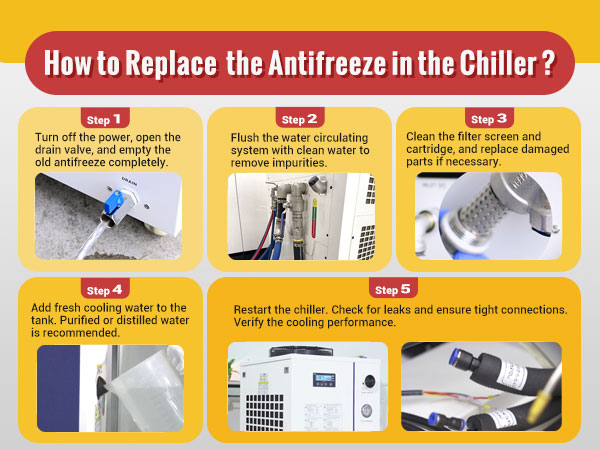When the temperature remains above 5°C for an extended period, it's advisable to replace the antifreeze in the industrial chiller with purified water or distilled water. This helps reduce corrosion risks and ensures stable operation of the industrial chillers. As temperatures rise, timely replacement of antifreeze-containing cooling water, along with increased cleaning frequency of dust filters and condensers, can prolong the lifespan of the industrial chiller and enhance cooling efficiency.
As the temperature rises, have you replaced the antifreeze in your industrial chiller? When the temperature remains consistently above 5℃, it's necessary to replace the antifreeze in the chiller with purified water or distilled water, which helps lower corrosion risk and ensure stable chiller operation.
But how should you correctly replace the antifreeze in the industrial chillers?
Step 1: Drain the Old Antifreeze
First, turn off the power of the industrial chiller to ensure safety. Then, open the drain valve and completely drain the old antifreeze from the water tank. For smaller chillers, you may need to tilt the small chiller unit to thoroughly empty the antifreeze.
Step 2: Clean the Water Circulating System
While draining the old antifreeze, use clean water to flush the entire water circulating system, including pipes and the water tank. This effectively removes impurities and deposits from the system, ensuring smooth flow for the newly added circulating water.
Step 3: Clean the Filter Screen and Filter Cartridge
Long-term use of antifreeze may leave residue or debris on the filter screen and filter cartridge. Therefore, when replacing the antifreeze, it's essential to thoroughly clean the filter parts, and if any components are corroded or damaged, they should be replaced. This helps improve the filtration effect of the industrial chiller and ensures the quality of the cooling water.
Step 4: Add Fresh Cooling Water
After draining and cleaning the water circulation system, add an appropriate amount of purified water or distilled water to the water tank. Remember not to use tap water as cooling water because impurities and minerals in it can cause blockages or corrode the equipment. Additionally, to maintain system efficiency, cooling water needs to be replaced regularly.
Step 5: Inspection and Testing
After adding fresh cooling water, restart the industrial chiller and observe its operation to ensure everything is normal. Check for any leaks in the system and ensure all connections are securely tightened. Also, monitor the cooling performance of the industrial chiller to verify that it meets the expected cooling effect.

Alongside replacing the antifreeze-containing cooling water, it's crucial to regularly clean the dust filter and condenser, especially increasing the cleaning frequency as temperatures rise. This not only prolongs the lifespan but also enhances the cooling efficiency of industrial chillers.
If you encounter any issues during the usage of your TEYU S&A industrial chillers, feel free to contact our after-sales team through [email protected]. Our service teams will promptly provide solutions to troubleshoot any industrial chiller problems you may have, ensuring swift resolution and continued smooth operation.
We're here for you when you need us.
Please complete the form to contact us, and we'll be happy to help you.
Copyright © 2025 TEYU S&A Chiller - All Rights Reserved.